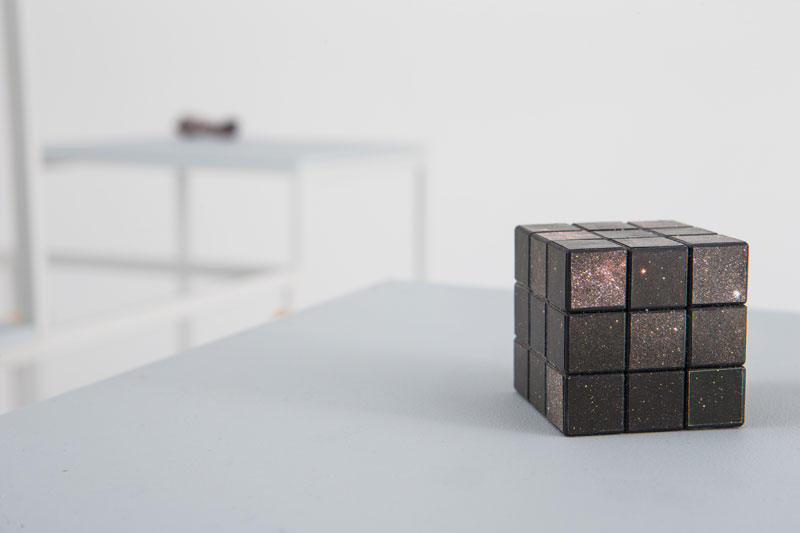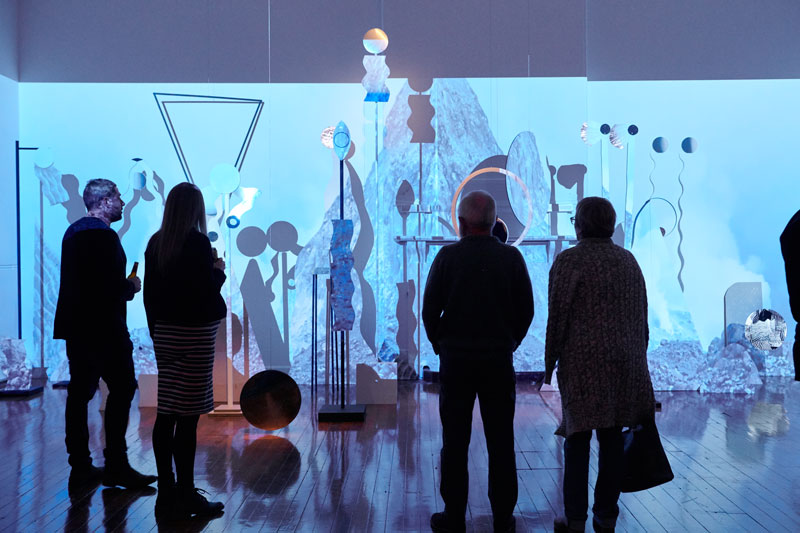
In an advertisement from 1999 for the Sony PlayStation by Chris Cunningham, an adolescent girl in a spare white-walled room presents an impressively succinct critique of the universalism and technocratic optimism of much twentieth-century thought. The girl states, “Let me tell you what bugs me about human endeavour: I’ve never been the human in question, have you? Mankind went to the moon; I don’t even know where Grimsby is. Forget progress by proxy. Land on your own moon. It’s no longer about what they can achieve, out there on your behalf, but what we can experience, up here [pointing at her temple] in our own time. It’s called: mental wealth.”
This short monologue highlights the ambivalence that haunts science fiction and the discourses of futurism. Was the moon landing a triumph for the human race, or was the spectacle of planting the American flag on the moon an expression of US hegemony, underpinned by a colonialist logic? Have the rapid advancements of consumer technology and social media trapped us in a perpetual cultural twilight? Or has the power of the internet, video games and wearable technology ushered in a liberating epoch of personalisation and individual autonomy? Have we lost the capacity to collectively dream, or were such dreams ideological nightmares of conformity and domination?
Such questions resonate strongly with the ambitions of Erin Coates and Jack Sargeant, curators of Other Suns: Cult Sci‐fi Cinema and Art. In interviews and a zine accompanying the exhibition, Coates and Sargeant frame the exhibition as a celebration and exploration of the fringes of the science fiction genre: the schlocky, B-grade, low budget, and counter-cultural. This is an impressively diverse exhibition of video art, sculpture, painting, screen media and installation work by national and international artists.
In critical response to the media and entertainment industry’s investment in CGI perfectionism, Coates articulates Other Suns as an exploration of the “underbelly” of the science fiction genre, and more individual visions of science fiction. For Sargeant, the exhibition maintains a critical distance from the empirical precision of “hard” science fiction by turning towards the sciences that are less culturally influential than physics, to also support modes of imagination less polished than blockbuster movies and the literary novel.

Taken collectively, the works presented in Other Suns are a love letter to the low‐budget aesthetics of much counter-cultural and B-grade science fiction cinema. Lisa Sammut’s atmospheric and mesmerising installation, A Monumental Echo, speaks to “space age” 1960s furniture design and the props and monuments of cult sci-fi. Matthew Bradley’s sculptural works invoke the MacGuffins of genre cinema, suggesting an odd blend of engineered utility and aesthetic ornamentation that could invoke an alien culture or a now-extinct advanced civilisation. Similarly, Boyden Woods’ paintings create resonances between the Australian landscape and the speculative environments of science fiction posters and book jackets. This vibrant and (to an extent) nostalgic reflection suggests that Other Suns is a celebration of a variety of science fictions. But as a counterpoint to such vibrancy, the show overall seems to be held together by an atmosphere of melancholic longing.
Certain works seem to bring this melancholy more sharply into focus. For instance, Roy Ananda’s seemingly unsolvable Rubik’s cube Blasphemous Infinity is structurally identical to the standard multi-coloured version, but adorned with different snatches of the cosmos, and his audio work Vader Loop is a locked groove vinyl record that plays a loop of Star Wars villain Darth Vader’s iconic mechanical breathing, both prompting wry associations between sci-fi’s once-speculative ambitions and its now exhausting continuation. In the climate of prequels, remakes, and reboots, the endlessly looping permutations implied by Ananda’s work convey the depletion of advancement that is also perceptible in Claire Evans’s looped footage of “wormhole” sequences from science fiction film and television.
This marriage of the playful and the despondent is apparent in Never Better by Jess Day and Joanne Richardson. On the one hand, the ramshackle DIY spaceship built by the pair suggests the exuberance and energy of a children’s education program—science fiction à la Playschool or Art Attack. On the other hand, the chaotic assemblage that comprises Never Better connects to the aesthetics of the post-apocalyptic and dystopian; as if the sculpture was a product of a culture that had long ago lost the ambition or ability to travel into space, and could only produce memorial artefacts of a perhaps more advanced bygone age.

Dan Bourke’s juxtaposition of worn paperback copies of science fiction texts and custom designed t-shirts—adorned with, amongst other things, references to the contemporary speculative thinker Donna Haraway— highlights the now-multiple generations of commodified imagination, presenting a juxtaposition of the beasts and monsters of science fiction narratives with the commercialisation of cult by way of Hypebeast. Lastly, Neil Aldum’s video work for Other Suns depicts the artist, adorned in a space suit and holding a white flag, playing out a make‐believe moon landing scenario. Backgrounding Aldum’s somewhat farcical performance is a University of Western Australia advertisement on a public billboard that uses moon landing iconography and is adorned by the slogan “pursue impossible”. Once again, this work revels in low-budget restaging of the visual culture of space travel, whilst also suggesting something more acerbic and droll. How should “pursue impossible” be taken here? As an invocation of the human capacity to deliver the unimaginable? Or, more disappointingly, as a Sisyphean task?
This deflation prompts further observation on what is being longed for or missed. In an opening night speech, art theorist Darren Jorgensen posed the question as to whether the cultural imagination once offered by science fiction has any real traction now, given the power for capitalism to rapidly transform entire ways of life and ecosystems. For Jorgensen, the incredible pace of development and technological change witnessed in countries like China has collapsed the distinction between the present and a scientifically advanced future, to the extent of making ineffectual such modes and models of speculation. This line of critique has strong affinities with contemporary theory—especially that of Mark Fisher, Franco “Bifo” Berardi, and Fredric Jameson—and, it would be fruitful to read the works in Other Suns in conjunction with this radically and progressively new marker of the loss of the future. Nevertheless, I would argue, it is the model not the future that is in decline here, as the loss is more specific to the underground, cult, and counter-cultural worldview.
.jpg)
Indeed, one of the stranger outcomes of the experience of viewing Other Suns is the realisation of science fiction’s mainstream status in contemporary culture. Internet meme culture has made the bizarre and visually jarring pass as normal, and the “viral” status of cultural objects sees them quickly and easily adopted by commercial interests. tcertainly monetisable. The experience of being online is like participating in a continuous episode of Mystery Science Theatre 3000, through which platforms like YouTube and Twitter throw up a seemingly endless supply of bizarre and fringe media that are ironically enjoyed, mercilessly mocked, and sometimes genuinely embraced. It could be the case that the speed of distribution facilitated by the contemporary circuits of mass media, and the myriad methods for commodifying images and video offered by the internet, has made it significantly more difficult to find the counter-cultural. Indeed, as ARIs and independent bookshops and video stores disappear (with the latter having almost entirely vanished) all that seems to be left are the increasingly all-encompassing platforms: Amazon, Facebook, YouTube, Netflix, etc.
If the cult and counter-cultural has largely disappeared, and if Other Suns can be legitimately read as a love-letter to the twentieth-century’s plethora of fringe, weird, and rebellious science fiction, now looked back on with melancholic longing, we should also ask how we distinguish the imaginative and visionary creativity of these fringe works from the atomised individualism of contemporary consumer-culture. To return to Chris Cunningham’s “mental wealth”, and Erin Coates’ curatorial interest in science fiction as a vehicle for individual imaginings, it is worthwhile considering how the desire for the fringe, weird, counter-cultural and/or rebellious is already adopted by today’s hegemonic mass culture. Indeed, it’s possible that a rejection of “progress by proxy” leaves open the intensification of the individual consumer and their isolated experiences as the dominant cultural horizon. None of which is intended as a criticism of Other Suns. Indeed, by focusing on the aesthetic of those other science fictions—those less polished, refined, heroic, and (if I can be excused a little jargon) phallogocentric forms of expression—the exhibition also invites significant questions about what it would mean to affirm a different kind of imagination in representations of the future. While the works exhibited in Other Suns don’t offer a new vision of the future, they nevertheless remind us of a time when multiple futures were being imagined.
